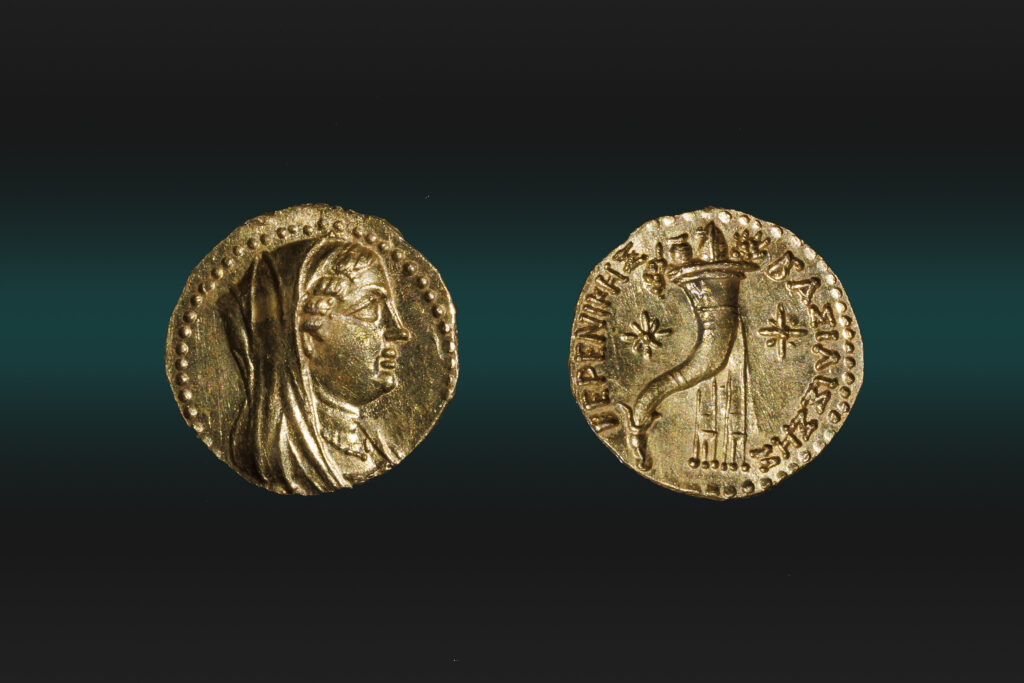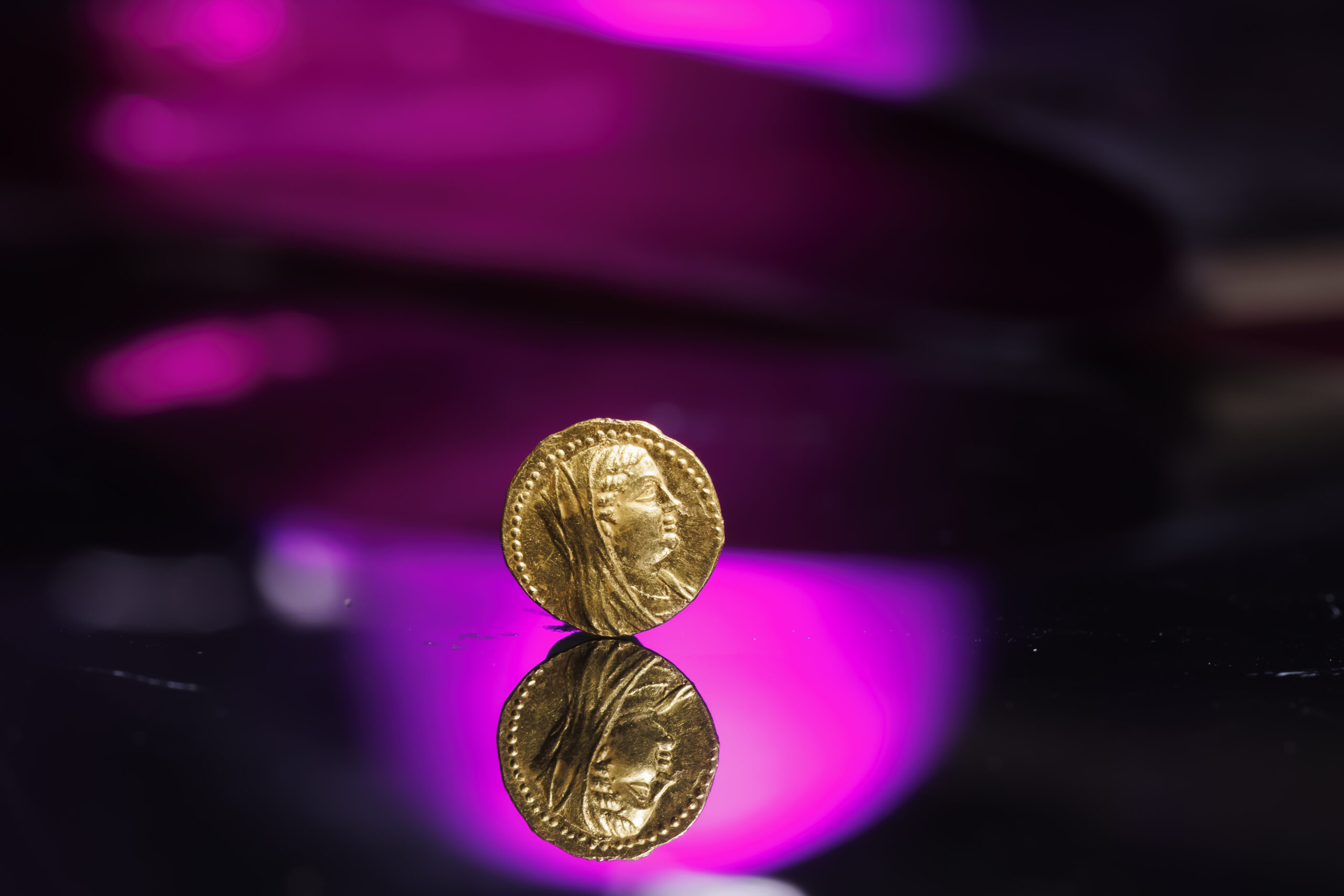A rare gold coin bearing the image of Queen Berenice II of Egypt has been uncovered in the City of David, offering fresh insight into Jerusalem’s role and stature during the Hellenistic period. The discovery, made in the Givati Parking Lot excavation under the direction of the Israel Antiquities Authority, dates to approximately 2,200 years ago and is the first of its kind to be found in a controlled archaeological context.

Both sides of the gold coin of Queen Berenice. Photo: Eliyahu Yanai, City of David.
The coin, a small quarter-drachma minted in pure gold of nearly 100 percent purity, was issued between 246 and 241 BCE during the reign of Ptolemy III, Berenice’s husband and the Hellenistic ruler of Egypt. Only about twenty such coins are known to exist worldwide, and until now all of them were known only from Egypt. The Jerusalem find, therefore, represents a unique connection between the Ptolemaic world and the city, challenging long-standing scholarly assumptions that Jerusalem after the destruction of the First Temple was a minor and impoverished settlement.
On the obverse, the coin shows Berenice adorned with a diadem and veil, a necklace draped around her neck, projecting an image of Hellenistic majesty. The reverse depicts a cornucopia, symbol of prosperity and fertility, flanked by stars, accompanied by the Greek inscription “of Queen Berenice.” Notably, the coin bears the title Basilisses – “of the Queen” – marking one of the earliest instances in which a Ptolemaic queen appears with an official title in her own right. This is an unusual assertion of female authority within a dynasty dominated by kings and provides a glimpse into Berenice’s exceptional political stature.
The find was made during routine soil sifting by Rivka Langler, an excavator working at the Givati site. “I was sifting the soil when suddenly I saw something shiny,” she recalled. “When I realized it was a gold coin, I couldn’t believe it. I had been waiting two years for my special find, and this was it!”
Scholars believe the coin was struck in Alexandria and may have been part of a donative series given to soldiers returning from the Third Syrian War (246–241 BCE), one of the major conflicts of the era between the Ptolemaic Kingdom of Egypt and its chief rival, the Seleucid Empire of Syria. The war was not just a contest of territory but a struggle between two of the great Hellenistic successor states of Alexander the Great’s empire.
The connection between Berenice and the Seleucids is particularly relevant to Jewish history. The Seleucid dynasty, ruling from Syria, would later produce Antiochus IV Epiphanes, infamous in Jewish memory for his persecution of Judaism and the desecration of the Temple, which ultimately sparked the Maccabean Revolt in the 2nd century BCE. The Third Syrian War in which Berenice’s Egypt triumphed represented an earlier stage of this long struggle between Ptolemies and Seleucids, a rivalry that set the stage for the turmoil and oppression experienced in Judea under Seleucid domination. The presence of Berenice’s coin in Jerusalem may therefore symbolize not only the city’s ties to the Ptolemaic sphere but also its precarious position in the geopolitical contest between these two powers.
Dr. Robert Kool, Head of Numismatics at the Israel Antiquities Authority, and Dr. Haim Gitler, Chief Curator of Archaeology at the Israel Museum, emphasized the rarity and significance of the discovery. “Only twenty of these coins are known, and this is the first to emerge from a scientific excavation,” they explained. “Its presence in Jerusalem provides unique evidence of the city’s ties to the Hellenistic world at a time when it was regaining its status after the destruction of the First Temple.”
Yiftah Shalev, director of the Givati excavation, added that the find overturns earlier assumptions of Jerusalem’s weakness in the Persian and early Hellenistic eras. “The prevailing scholarly view was that post-586 BCE Jerusalem was marginal and economically stagnant,” Shalev noted. “But discoveries such as this coin indicate that Jerusalem was already reviving in the Persian period and growing in strength under Ptolemaic rule. Far from being isolated, it was connected to the great political and economic networks of the region.”
The discovery also carries modern resonance. Israel’s Minister of Heritage, Amihai Eliyahu, remarked: “Jerusalem never ceases to surprise. The rare coin may be small, but it illuminates a critical chapter of our city’s history. After 2,000 years, we are privileged to uncover its past and reconnect with its story.”
The gold coin of Berenice II will be displayed to the public for the first time in early September at the annual City of David Research Conference, alongside other gold artifacts unearthed in the same excavation.




